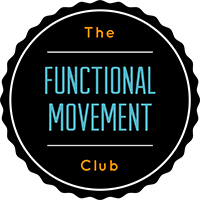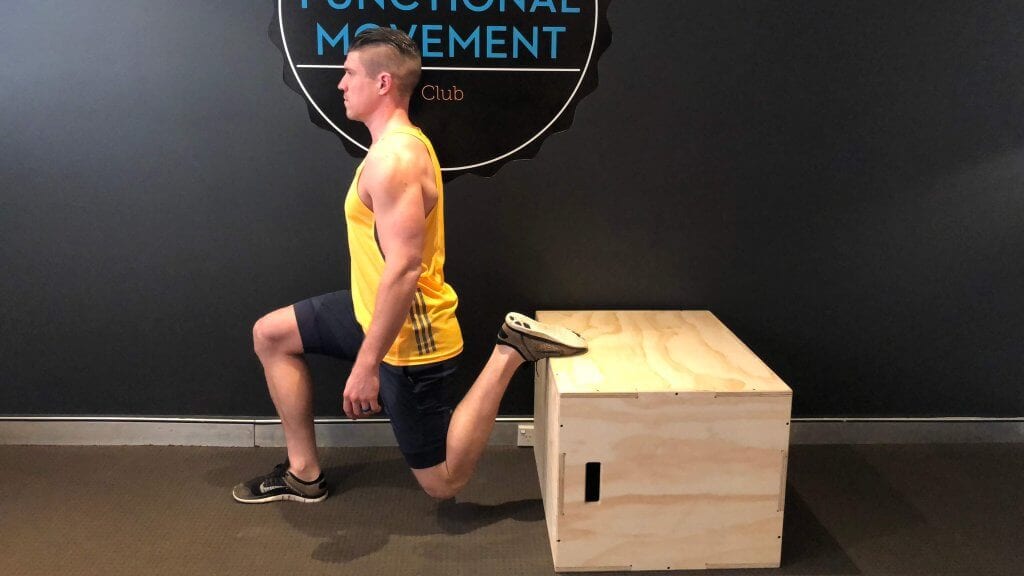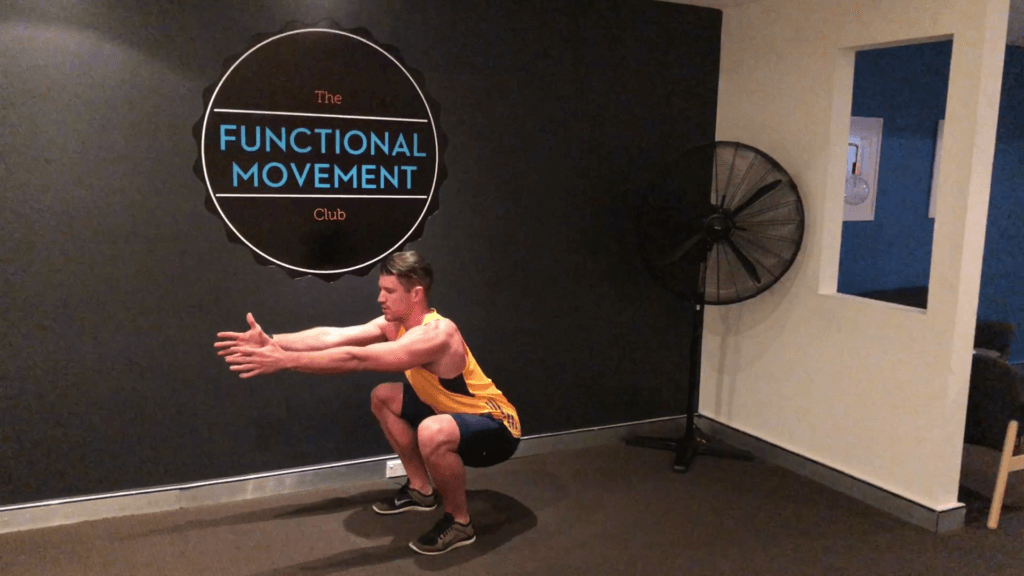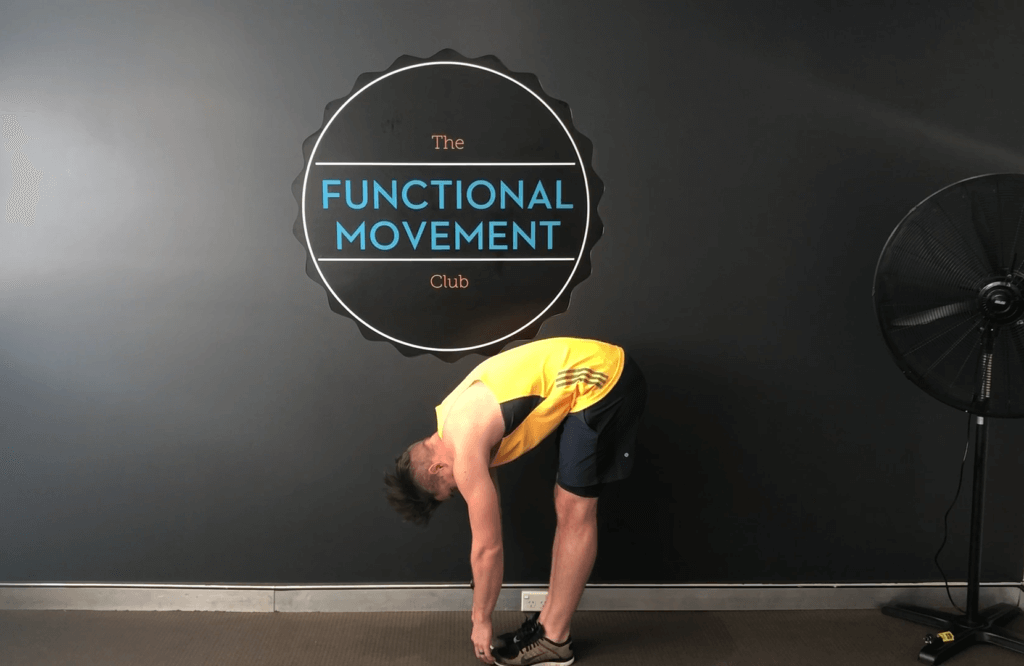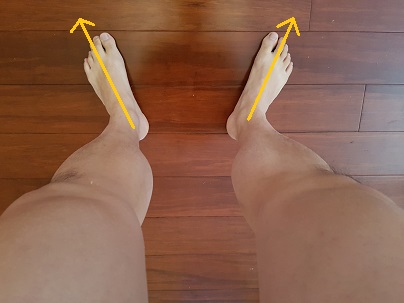
The Problem With Your Duck Feet
Do You Have Duck Feet?
Take a look down at your feet. Do your feet point straight ahead, or do they point out? If your feet point out, this is what is commonly called being duck-footed.
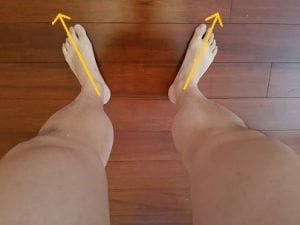
Depending on how low you have been standing and walking around like this, you may not notice any issues with it. . . Yet. If you have had it some time, it could be causing what is causing that pain in your foot, knee, hip, or lower back.
Whilst having duck feet probably won’t kill you. It can mean you are leaving a lot in the tank at the gym or in your chosen sport. If none of the above pains has crept up on you, it increases your risk of pain in the future.
You see, the body is an amazing compensation machine. Whether you realise it or not. Every time you change your biomechanics (the way to move), it puts extra stress on surrounding tissues. Eventually, if you put too much stress on them, the dam wall will break, and pain will come flooding in.
PSST . . . Heres a FREEBIE I made for you
So What If I Have Duck Feet?
You may not consider your duck feet a problem. “It’s no big deal. Look at how many other people walk with the feet pointing out” (it is actually scary how common this is becoming). Next time you are in a busy place like the shops or on a busy street, look down at a few people’s feet. But just because everyone is doing it, it means that it is normal.
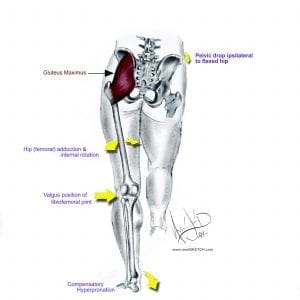
Having duck feet is a bit like driving a car around flat tires and your wheels out of alignment. You’ll get pretty crappy mileage, and the ride will not be smooth or comfortable.
What That Actually Means.
Turning a foot out causes the arch to collapse (pronate). The more your foot turns out, the flatter your foot will become.
When you walk, run, jump or squat, your body has to work harder to stop the arches of your foot from collapsing. This means your shin bone (Tibia & Fibula) will internally (inwardly) rotate, which can lead to overuse injuries of the muscle around your shin. Run your finger up the inside of your shin. Is it a little tender?.
If your shin keeps rotating in, your leg will want to collapse. To counteract this, the Femur (thigh bone) externally (outwardly) rotates. Then to keep your thigh bone out, you end up recruiting your deep hip externally rotators (check out our previous blog for the hip muscles and their function) instead of your gluteal muscles (one of the reasons you need to do so much glute activation). This has a flow-on effect of an anteriorly (forwards) rotated hip and increased curve/stress on your lower back.
This should give you an appreciation for how much extra effort is for you to walk around and sit with your feet out all day. Now it’s time to dig a little deeper into the specific areas it affects.
Duck Feet: Your Ankles and Feet
Reduced Shock Absorption
The arch of the foot is designed to provide shock absorption when walking, running and jumping. It stores energy from your foot coming in contact (stored energy) with the ground and translates it into kinetic energy (movement).
When your foot is flat, your Plantar Fascia is under constant stretch (think heel pain in the morning). The Plantar Fascia is a band of connective tissue which helps form the arch of the foot. It works as an elastic band to keep us moving forward when walking or running.
Several muscles also work to help support the arch of the foot. We call these the intrinsic muscles of the feet (they have their origins and insertions inside the foot).
When your foot is rotated out, the arch is stretched and flattened. This puts these muscles into a lengthened position. These muscles also don’t have to work as hard as more of the foot is now resting on the ground.
They go on holiday and start sipping coronas on a beach in Mexico. This becomes an issue as your brain receives less neural feedback from your feet, leading to balance and joint proprioception (think joint positioning, kind of like satellite navigation for your car but in your brain).
This means the extrinsic muscles of the foot (muscles the originate outside the foot but insert into the foot bones), like the Tibialis Anterior, Tibialis Posterior, Flexor Hallucis Longus & Flexor Digitorum Longus, all have to work harder all day. If you are anything like me, I whine and complain when I feel I have to do more work than I should.
Whilst the big extrinsic muscles of your foot can compensate for the movement part of your foot, they are lousy at controlling the small intricate movements of your feet, such as shock absorption.
Ankle Stability
The intrinsic muscles are also responsible for your ankle stability. They are quick and react to your foot being placed on uneven surfaces. They are also supposed to communicate with your brain to help with balance and make sure that they can react and save you from rolling your ankle or falling over when you do get a little unsteady. If you have ever rolled your ankle in the past, this is one of the major causes for the intrinsic muscles not communicating with the brain as effectively as they should.
To test this out, stand barefoot with your feet about hip-width apart. Slowly raise one knee to align with the hip, get your balance, close your eyes, and count to 30. If you feel like your going to fall over, open your eyes or do it next to something you can grab onto. Then repeat on the opposite side. If you can’t do this or look like you are swatting away imaginary flies, you need to wake your intrinsic feet muscles up (keep reading below)
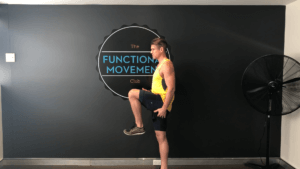
Duck Feet: Your Knees
Medial Collateral Ligaments
So now that your feet have flattened, the shins start to rotate in. Your knees are excellent hinge joints (like a door) that swing open and closed but don’t like to rotate a lot. The inward rotation of your Tibia and outward rotation on the femur place increased stress on your medial collateral ligament (MCL), which is a ligament on the inside of your knee.
The MCL is also attached to the medial Meniscus, one of the two shock absorbers deep in the knee. The Meniscus also helps the bones in our knee glide properly.
If the MCL is under constant tension is can lead to increased wear and tear on your Meniscus.
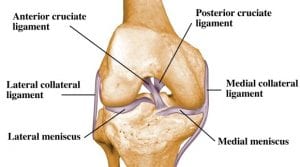
Cruciate Ligaments
Inside your knee, you have two ligaments called the Anterior and Posterior Cruciate Ligaments. They form a cross deep within your knee joint like a rope, which stops your tibia and femur from sliding too far forwards and backwards on each other.
Turning your foot out unwinds these ligaments like a rope unwinding. This decreases the stability of the knee joint. Decreased stability in the joints means your muscles have to work harder, making your body burn more energy until eventually, the muscles give up, and you start laying down extra bony growths (a term called degenerative joint disease)
When your cruciate ligaments are placed under constant tension, they can tear or completely rupture.
Duck Feet: Your Hips and Back
Decreased Glute Activation
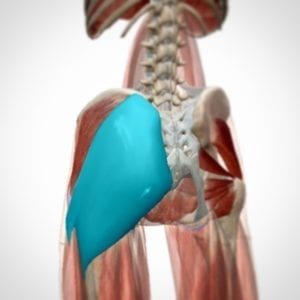 The Gluteal muscles are a large group of muscles (in size comparison) that surround the hip. They are prime movers as well as stabilizing muscles of the hip. The Gluteus Maximus is a primary hip extender and external rotator. The Gluteus medius is a secondary (helps glute max) hip extender and external rotation and a primary lateral hip stabiliser.
The Gluteal muscles are a large group of muscles (in size comparison) that surround the hip. They are prime movers as well as stabilizing muscles of the hip. The Gluteus Maximus is a primary hip extender and external rotator. The Gluteus medius is a secondary (helps glute max) hip extender and external rotation and a primary lateral hip stabiliser.
During movement, the Gluteal muscles help to prevent/decelerate your knee from collapsing. It also helps maintain the arch in your foot. Without this brake like action, everything collapses in.
Turning the foot out shortens your glutes and reduces your ability to contact them further.
Try the following:
Stand up with your feet at hip-width and your toes pointing straight ahead. Squeeze your Glutes together and try to pull the floor apart using your big toes (imagine trying to stretch the floor between your feet). Now relax, turn your feet out and squeeze and again. You will notice that it’s a lot harder to contract your glutes and pull the floor apart with your feet like this.
Shortened Deep Hip External Rotators
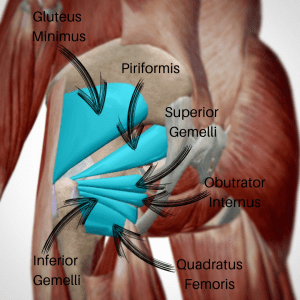 The Deep Hip External Rotators are a group of small muscles that runs from your sit bone to the outside of your Femur. When you turn your foot outwards, these muscles are put into a shortened position. If you spend enough time in this position, the body will think this is a normal resting length. The muscle shortens as it is only every required to work within this small range of motion.
The Deep Hip External Rotators are a group of small muscles that runs from your sit bone to the outside of your Femur. When you turn your foot outwards, these muscles are put into a shortened position. If you spend enough time in this position, the body will think this is a normal resting length. The muscle shortens as it is only every required to work within this small range of motion.
As mentioned above, with the foot turned out, the Glutes can’t function as effectively. The body, therefore, has to find other ways to help prevent/decelerate the collapsing of the knee and foot arch. It accomplishes this by getting the Deep Hip External Rotator muscles to help out.
These muscles are relatively small when compared to the Glutes and are not designed to do this. They get annoyed with having to do so much work as they are already in a shortened position. The muscle becomes hypertonic (stiffer) and can put pressure on the Sciatic nerve (the major nerve that affects muscles and arteries of your leg all the way down to your toes).
Spinal Alignment & Leg Length
As already mentioned, an externally rotated leg causes the foot’s arch to collapse, which effectively shortens the leg. The body now has to compensate for this up through the rest of the system. It does so by internally rotating your shin and externally rotating your femur.
Naturally, the hip bone wants to maintain the greatest surface area contact with the femur, so it is the next structure to have a compensatory pattern. The external rotation of the femur means the hip tilts forward to maintain as much contact with the femur as possible.
If one side is more externally rotated and the foot is flatter on that side, it can lead to a functional (occurring as a compensation) leg length discrepancy, which places increased workloads on the lower back.
The Lumbar spine (lower spine) now has to rotate slightly and flex to keep your body upright, and further compensations occur as you travel up your spine.
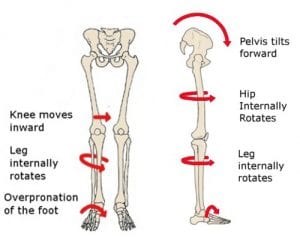
Why Do My Feet Turn Out?
Like many postural problems, flat out-turned feet can be split into two main categories.
It could be something you were born with, otherwise known as a congenital abnormality. Or it could be Acquired, something that has developed possibly due to; injury, disease or behaviour.
It is likely something you have acquired over the years as in Australia (at least) early screening will normally show up and congenital abnormalities.
Rolling your ankle is a pretty common way of decreasing the messages coming from your foot to your brain and decreasing the ability of the intrinsic foot muscle to lengthen and shorten. Other back injuries can cause inhibition of your Gluteals, or even something as common as sitting for extended periods of time can lead to tight hips and cause your feet to turn out.
What Can I Do About It?
If it’s a congenital problem, there honestly isn’t much you can do about it. It just means you have to make sure the other leg areas are in good working order and able to handle your compensations.
If the problem is acquired, then the good news is you can take back control of your body. Working in increasing foot proprioception (joint position), increasing glute activation, and strengthening up the lower limb will all pay for themselves in the long run. Our best exercises to help treat this common condition include:
- Rolling out your foot with a ball (golf ball works best)
- Small Foot
- Small Foot with ankle proprioception (move other Leg Forwards and back)
- Glute Activation
If you can strengthen the problem areas and retrain your muscles to hold you in a better position, the body will naturally want to return to a more neutral posture.
As always, if you are concerned about your health and posture, go and get yourself checked out by a professional. If you found this article useful, please throw me a bone and share it with others.
Once you have your duck feet sorted, it may be worth checking out how to Fix Your Hip Extension. If you squat (hint everyone does every day, why not check out Why My Squat Is Different To Your Squat? Whilst you are on the mobility Path, we love Mobility vs Flexibility: What You Need To Know To Reach Your Goals.
